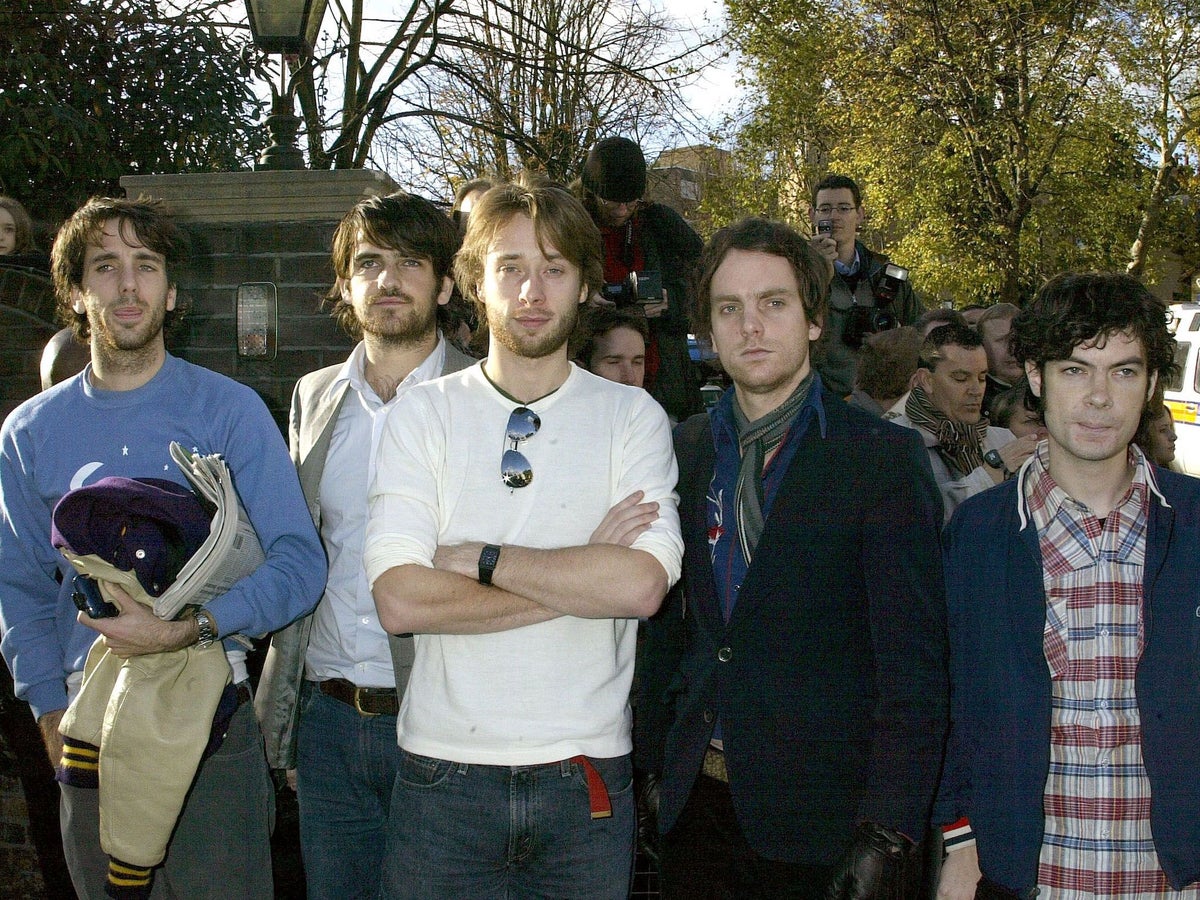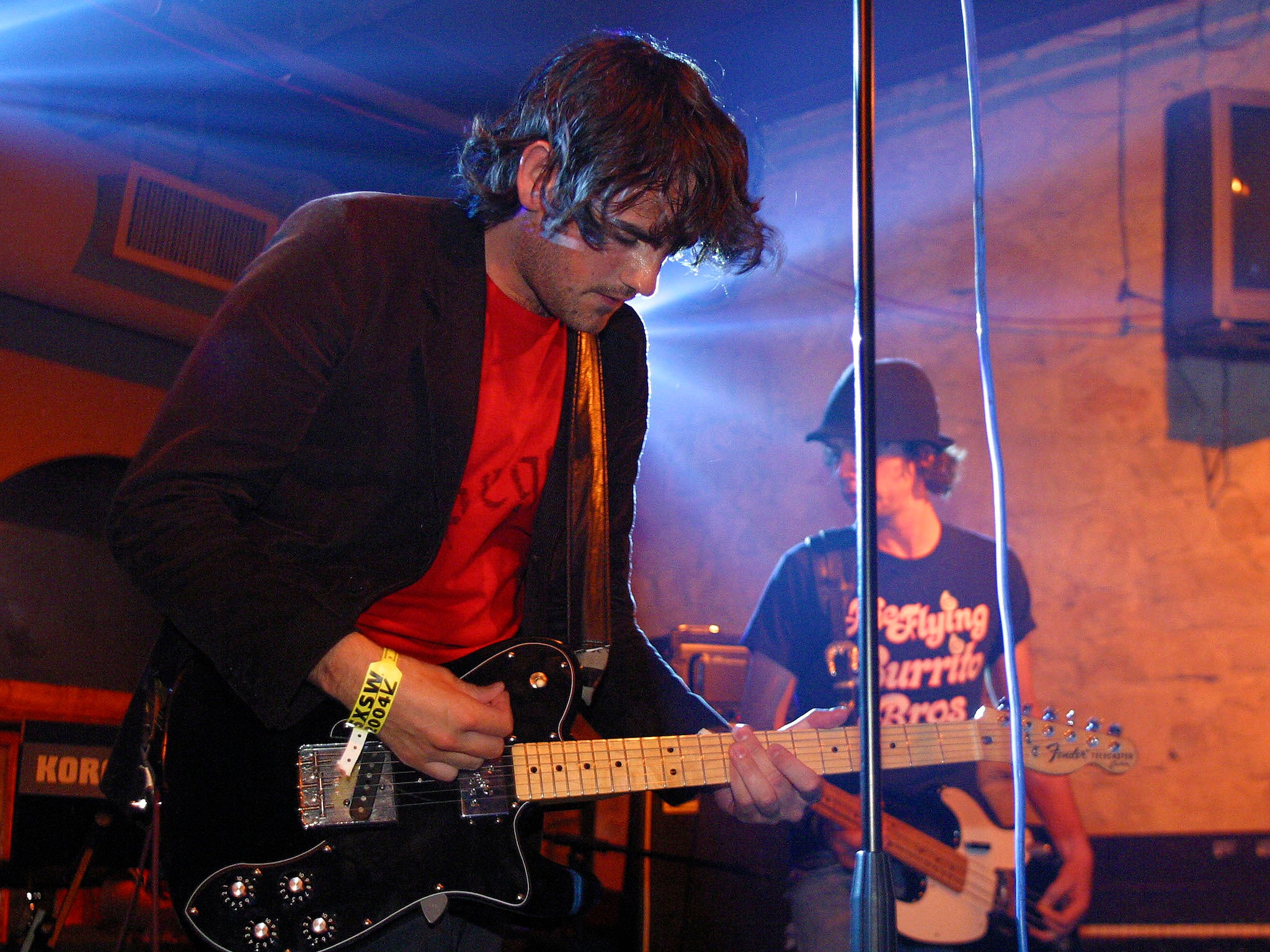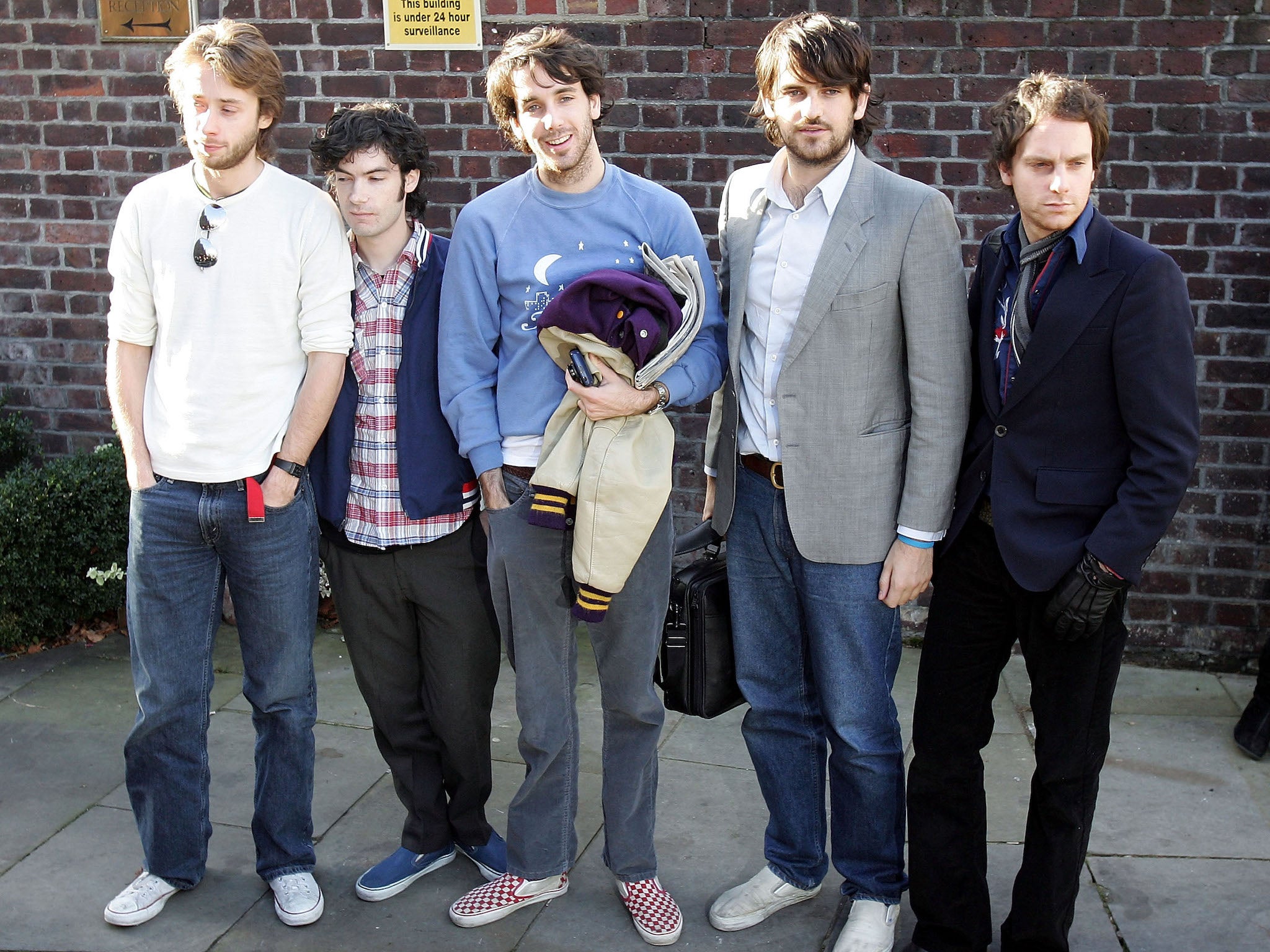
The Thrills had been delighted to go for dinner with Morrissey. It was on a hazy afternoon two decades ago that the young Dublin band met with their celebrity fan at the Pig ’n Whistle on Hollywood Boulevard, a famed expat hangout in Los Angeles. It was going well. They were laughing, joking. Morrissey, who had suggested the group give him a call if they were passing through his adopted home, even floated the possibility of The Thrills supporting him on tour. But then things suddenly took a turn when the band’s guitarist made the faux pas of asking the Smiths frontman if he might be open to becoming an honorary Thrill.
“We knew Morrissey liked our song ‘One Horse Town’. He had put the demo version on the mixtape of his most recent tour,” recalls singer Conor Deasy. “We’re chatting, and Daniel, our guitarist, goes, ‘Morrissey, we’re just finishing up the mix to [the official studio version] ‘One Horse Town’. Would you like to do backing vocals?’ Morrissey said [adopts aloof ‘Moz’ voice], ‘I don’t do backing vocals’. There was a slight pause and then Daniel says, ‘What about singing the last chorus?’ And Morrissey goes, ‘I don’t do last choruses’. That was our introduction to Morrissey.”
Morrissey was sincere in his love of The Thrills – the Irish band with the Golden California sound who released their debut album, So Much for the City on 27 May, 20 years ago this month. He was just one of many famous fans who swooned over the quintet’s Seventies harmonies, Beach Boys melodies and lyrics that cast the American West Coast as a place of escape and self-realisation. In a breathtakingly brief career, The Thrills supported The Rolling Stones and were championed by R.E.M. Kings of Leon producer Ethan Johns unsuccessfully lobbied to oversee their second LP, Let’s Bottle Bohemia. For a heartbeat, they were the buzziest band on the planet.
They were also one of modern rock’s ultimate boom-to-bust stories. So Much for the City debuted at No 3 on the charts and received a Mercury Music Prize nomination (losing to Dizzee Rascal’s Boy in da Corner). The Independent awarded it four stars. “Sparkling,” swooned Spin. “Their convincing tribute to Neil Young and the Byrds is quite lovely,” said Entertainment Weekly. Having soared so high, however, the band quickly tumbled earthward. Just five years after So Much for the City, The Thrills played their last-ever gig at the 700-capacity Amplifier Capitol in Perth, Australia. They had by then become a zombie band, half-forgotten by many of their fans and, even more so, their famous cheerleaders. Today, having long disbanded and with no interest in reforming, they look back at their rise and fall with an air of disbelief. Did this all really happen to them – five suburban kids from Dublin?
“We signed a deal in late August or early September [2002]. By October, we were in LA recording the album – it happened that quickly,” recalls guitarist Daniel Ryan, a solicitor in Dublin today. “We had been played on [Steve] Lamacq a little bit. While we were out there, Jo Whiley started playing ‘One Horse Town’ [on BBC Radio One]. You’ve got to remember there was no YouTube, there was just nothing. If you had that platform in the UK, the reach was incredible. We announced a tour in late November, December. We came back – everything was sold out, on the back of four or five Jo Whiley plays and an article in the NME. Morrissey had endorsed us as well. Morrissey hadn’t spoken to the NME in years, and he had given us his phone number.”
The Thrills’ golden sound was rooted in the California soft pop of the Seventies. “One Horse Town” was Gram Parsons meets The Beach Boys; “Santa Cruz (You’re Not That Far)”, their other big hit, plundered Harvest-era Neil Young, with classic Burt Bacharach stirred through for good measure. The band didn’t just sound the part: they looked it, too. The cover of So Much for the City features the quintet with stylishly unkempt hair and clear eyes, as if they’d just stepped out of Joni Mitchell’s lounge circa 1972. (The two women posing alongside them were strangers rounded up by The Thrills’ label, who felt a female presence on a record sleeve added an air of mystery). “I work in music education and there are so many great musicians. But sometimes you meet them and you’re a little disappointed. You meet [The Thrills] and your work is already done,” says their former manager Alan Cullivan of the group’s shaggy Seventies chic. “You think, ‘I don’t even have to get involved in [their image]’. They have an understanding of that already.”
Cullivan, today a lecturer at BIMM music college in Dublin, feels The Thrills came along at the perfect time. Their sound tapped into the resurgence of The Beach Boys that had ensued following the return of their eccentric leader Brian Wilson to touring in the late Nineties. Meanwhile, more generally, rock music was in the midst of a renaissance, led by trendy New Yorkers such as The Strokes and Interpol. “The time was in their favour. The rock thing was coming along. You couldn’t have five Interpols. Or five White Stripes. It was almost like, ‘Interpol do this, The Strokes do that. And The Thrills guys do that’. That harmony-driven Beach Boys thing, it fitted straight in.”
With “One Horse Town” all over radio, The Thrills were heralded as an overnight success. In fact, Deasy and Ryan had been writing songs together since their teens, having grown up next door to one other. They met their future bandmates at Gonzaga College, one of Dublin’s most elite schools – it is also the alma mater of actor Andrew Scott and Game of Thrones star Jack Gleeson – and first played together at age 15. Their eureka moment arrived in the summer of 1999 when, after completing secondary school, they spent four months living in an apartment behind a record store on Mission Beach in San Diego, working service industry jobs by day and soaking up the vibes at night. Returning to glum Dublin and expanding the line-up to a five-piece, the friends turned to songwriting to evoke the escapism and excitement they’d felt in California. “You can’t underestimate the importance of going away from home for the first time,” says Ryan. “And being in an environment where we were just together and listening to a lot of music. You’d come back from the West Coast to a gloomy October. It was like, ‘We gotta get back to that place’. You were yearning to go back. The music [on So Much for the City] is uplifting, but lyrically it’s brooding and heavy and reflective.”

Dublin had a vibrant music scene at the time: in 2002, Gemma Hayes received a Mercury nomination for her shoe-gazey debut Night on My Side. But while it was relatively easy to become a big band in Ireland, building an overseas audience was tricky (and still is). Irish music is littered with artists acclaimed at home but who crashed and burned when trying to make an impact in the UK. In the case of The Thrills and their manager Cullivan, the solution was obvious: ignore Ireland and head straight for London. He had learnt this lesson with his Nineties indie trio, Puppy Love Bomb, and also when working with doomy Dublin trio JJ72. “It didn’t make any sense to me why you would put so much work into Ireland. Ireland generally doesn’t spill over to the UK. Whereas you put a lot of work into the UK and it will spill back,” Cullivan says. “That was the idea: we’d put the work in over there and it’s bound to spill back. And if it doesn’t spill back, fine. Using the contacts I had, I reached out in the tried and old way of 20 years ago, where you send burned CDRs and write an email, ‘Hey, it’s Alan, I met you, blah blah blah...’ It all kicked off once we got a call from Rough Trade.”
Rough Trade was one of several labels to bite. With the word out about The Thrills and their hazy, lazy sound, A&R men from several majors descended for a showcase at Temple Bar Music Centre in summer 2002. “It was just great seeing those songs played live. The band were lovely – oozed charm and personality. I wasn’t looking for stars. I was looking for a band that would become successful and get better with time. They seemed to fit that bill,” recalls James Endeacott, the high-powered A&R man who had previously signed The Strokes and The Libertines to Rough Trade (The Thrills were the ones that got away, ultimately opting for Virgin instead). “I just loved their sense of melody and the songs. They did look to America for inspiration but that felt a very Irish thing to me. The Irish have always had a fascination with the US, from Van Morrison to The Pogues and beyond,” he says. “Their harmonies were beautiful as well.”
“One Horse Town” and “Santa Cruz (You’re Not That Far)”had turned The Thrills into potentially the biggest Irish band since U2. Then, in March, they released So Much for the City, recorded with Air producer Tony Hoffer at the Sound Factory in Los Angeles and Area 51 in Dublin. The record, in turn, spawned another hit, “Big Sur”, named after a popular surfer spot in Monterey. Back home in Ireland, though, a backlash was gathering pace: the complaint being that The Thrills hadn’t paid their dues. They had also committed the unforgivable sin of being from the middle-class South Dublin suburbs of Blackrock and Foxrock. Posh and self-assured, they were a red rag to the scenesters. Not that The Thrills were too bothered, busy as they were playing to sell-out audiences across North America, the UK and the continent. They were too big for Ireland. It didn’t matter to them that Ireland was too small-minded for them.
“There was a backlash, and they didn’t care,” says Cullivan. “If you’re touring America, Europe or Japan, it didn’t matter if suddenly the market fell out of Ireland. It was a tiny, tiny market. Being involved in music for many years, [backlashes] still happen to artists I know today.” He continues: “The thing to remember is, rock ’n’ roll in Ireland is middle class, whether you like it or not. It is unusual for people who are in the music industry and are at a certain level not to be middle class. There are lots of socio-economic reasons for that.” Cullivan asks: “Did they get stick for being from South Dublin? Yeah. Does Conor O’Brien [from Villagers] get stick for being from South Dublin? No. It had to do with the level of success. You see it today with Fontaines DC – an amazing band [who get] abuse as well.”
That backlash never spread to the UK. Instead, something much worse happened. People moved on. Let’s Bottle Bohemia performed respectably in 2004; the single “Whatever Happened to Corey Haim?” – a reference to the briefly famous Eighties teen star – peaked at No 22 in the charts. But the hype around The Thrills was sputtering out. By 2007, when they released their final LP, Teenager, coiffured indie bands such as themselves were no longer in vogue. Not only that, but the music industry was struggling to cope with the effects of file-sharing. And when Teenager failed to chart, the label dropped them. It was over.

Deasy, who continues to work behind the scenes in music, enjoyed his time in The Thrills. But he was never entirely at ease in the spotlight. “At times, it did feel uncomfortable,” he says. “One time we were supporting the Rolling Stones at the Astoria in London. I was getting riled up, feeling that as a front person, I’ve got to be in the audience’s faces. I look back and wince a bit. Just because people expect the singer in the band to be this godly, obnoxious person, doesn’t mean you have to step into that role. When you’re young, you’re not sure how much to trust your instincts. It was bewildering at times.”
For his part, Ryan feels The Thrills would have fared better today with streaming having greatly reduced the influence of the music press and radio. When British radio stopped playing The Thrills 15 years ago, it was game over. Today, it probably wouldn’t matter. “I think we had a good chance of having success in America. The way music is with Spotify would have helped us. It was much harder to break different territories back then; the only outlets were radio and press,” he says.
In 2005, a band’s fate lay largely in the hands of their record label. Today, indie bands such as Working Men’s Club, Blossoms and The Cortinas have demonstrated that all you need is a loyal fanbase. That shift in the balance of power might have benefitted The Thrills, feels Ryan. “You had to have the record company in that area going out to bat for you; if they didn’t, you just didn’t exist there. We had good success in Italy, Japan and Australia. But had we some of the resources we had now... we may not have sold as many records, but your touring is different and, with streaming, the reach is much better. If fans want to stick with you, radio doesn’t matter. I’ve often said this to Conor: in some ways, I think it might have been better for us now.”
They still think of what might have been. But mostly they just reflect on what they achieved and wonder if it was all a dream. And there is so much to reflect on. That gig with the Stones. That time they covered Rod Stewart’s “Maggie May” with Ron Wood at an awards ceremony in Dublin. The party where Bono joked about wanting to be their roadie. And the evening they squeezed into a booth with Morrissey and heard him explain at length why he loved their music. “Morrissey said we were a mixture of The Partridge Family and someone else,” says Ryan. “He was very funny and really nice. Morrissey was not really giving interviews or anything at that time. It really shone a light on us – this guy hasn’t been seen for years and he’s talking about this band.”







